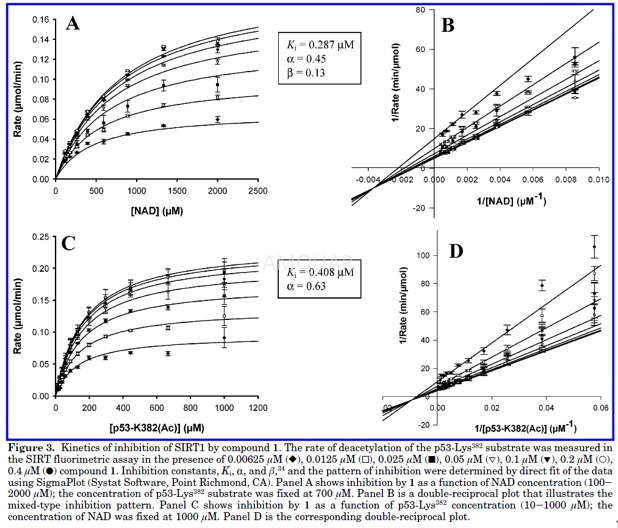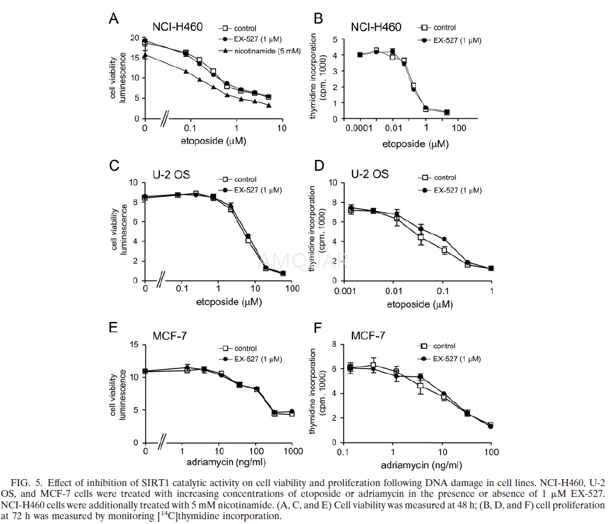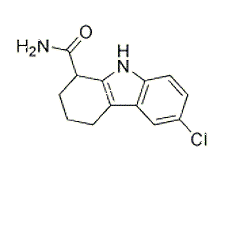-
生物活性
EX 527 is selective inhibitor of SIRT1 that does not inhibit histone deacetylase (HDAC) or other sirtuin deacetylase family members (IC50 values are 98, 19600, 48700, > 100000 and > 100000 nM for SIRT1, SIRT2, SIRT3, HDAC and NADase respectively). Enhances p53 acetylation in response to DNA damaging agents.
EX-527 inhibits SIRT1 expressed in bacteria with an IC50 of ~38 nM.[1]
EX-527 inhibits recombinant SIRT1 expressed and purified from mammalian cells with an IC50 of 38 nM.[1]
EX-527 inhibits SIRT1-catalyzed nicotinamide exchange reaction with an IC50 of 1.5μM.[2]
In Vitro Selectivity[2]

-
体外研究
-
体内研究
1% DMSO+30% polyethylene glycol+1% Tween 80
-
激酶实验
SIRT Fluorimetric Assay[2]
Human SIRT1 (N-terminal His6-tag) and SIRT2 (N-terminal GST tag) were expressed in Escherichia coli and purified by affinity chromatography. SIRT3 is synthesized in mammalian cells as an inactive precursor and activated by a mitochondrial matrix processing peptidase, which removes the first 100 amino acids. Therefore, N-terminal GST-tagged SIRT3 lacking the first 100 amino acids was expressed in bacteria.
The biochemical assay for recombinant human SIRTs was based on the SIRT1 Fluorimetric Drug Discovery Kit. In this assay, modified acetyl lysine conjugated to aminomethylcoumarin (AMC) is deacetylated by SIRT enzymes in the presence of NAD, followed by the addition of a proteolytic developer that releases the fluorescent AMC.30 KM values for NAD and acetylated peptide substrates with SIRT1, SIRT2, and SIRT3 were determined. Deacetylase reactions were carried out with all substrates fixed at 70% of their KM values. Enzyme was added at a concentration of 0.5 to 1.0 units/assay well (1unit of enzyme releases 1 pmol of product per min). Assays were incubated for 45 min at 37 °C. Resulting fluorescence was measured after further incubation for 15 min at 37 °C with Fluor de Lys Developer II on a Bio-Tek Synergy HT fluorimeter with excitation set at 360 nm and emission measured at 460 nm. Assays of SIRT1, SIRT2, and SIRT3 were performed in 384-well plates using the p53-K382-(Ac) substrate representing residues 379-382 of p53 acetylated on lysine 382. IC50 data were analyzed using XLFit (IDBS, Guildford, UK) or GraphPad Prism software.

-
细胞实验
Cell viability and proliferation assays[1]
NCI-H460 cells, MCF-7 cells, U-2 OS cells, or HMEC were plated at 2,000 cells per well in opaque-walled 96-well plates (Corning) for the viability assay and 800cells per well in 96-well Cytostar-T scintillating microplates for the proliferation assay. Cells were incubated for 1 day (NCI-H460) or 2 days (MCF-7, U-2 OS, and HMEC) prior to exposure to DNA-damaging agents and deacetylase inhibitors. All experiments were performed in triplicate.
For viability assays, cells were treated with the indicated compounds for 48 h. Cell viability was then determined using the Cell Titer-Glo luminescent assay, which measures total ATP levels as an index of cell number. Luminescence was measured on a Luminoskan Ascent .
For the proliferation assay, 0.5μCi/ml of [14C] thymidine was added to the medium immediately after the genotoxins and deacetylase inhibitors. Plates were counted at 48 h (HMEC) or 72 h (NCI-H460, MCF-7, and U-2 OS cells) in a Microbeta liquid scintillation counter. Thymidine incorporated by the cells was detected by proximity to the scintillant in the base of the Cytostar-T tissue culture plate. Values were graphed as means±standard deviations.

-
动物实验
Animals[3]
Male Sprague-Dawley rats (6- to 7-weeks-old, weighing 200-220 g) were obtained and kept under dim cyclic light (5Iux, 12 hour on/off, 6 AM-6 PM), with food and water available ad libitum.
To study the effect of EX-527 on HRS light-induced retinal damage protection, rats were randomly assigned into four groups (n = 6 per group): (1) an LE group, (2) an LE+HRS group receiving LE and HRS, (3) an LE+EX-527+HRS group receiving LE, HRS, and EX-527, and (4) an LE+ vehicle+ HRS group receiving LE, HRS, and vehicle (DMSO).
Light Exposure
Rats were dark-adapted for 12 hours, and then the rat's pupils were dilated with 0.5% tropicamide-phenylephrine ophthalmic solution. Rats were then exposed to 10000±100lux white light-emitting diode (LED) light for 3 hours. The environment was kept between 24oC and 26oC and the light exposure experiments were performed between 6 PM and 6 AM the next day. Immediately following the exposure period, rats were returned to dim cyclic light conditions (5 lux, 12 hours on/off).
Administration of Sirt1 Inhibitor
The Sirt1 specific inhibitor EX-527 was dissolved in DMSO at a concentration of 5μg/μI. Rats received intravitreal injections of 1 0μg EX-527 or the same volume of vehicle. Transresveratrol or EX-527 was given immediately after light exposure. EX-527 was given every 36 hours for 5 days, and REV was administrated daily for 5 days.
Measurement of Retinal Outer Nuclear Layer (ONL) Cell Layer Number
Five days after exposure, rats were intraperitoneally anesthetized with 10% chloral hydrate (3 mL/kg). Eyes were enucleated and immediately frozen in a Tissue-Tek O.C.T. compound. Retinal sections (10μm) were fixed in cold acetone and stained with hematoxylin and eosin. Images were captured using a digital imaging system for each section. The ONL cell layer number was determined by counting the nuclei in the ONL along the line vertical to the RPE. The layer number was measured at 0.4 to 0.5 mm, starting from the optic nerve head to the peripheral area.

-
不同实验动物依据体表面积的等效剂量转换表(数据来源于FDA指南)
|  动物 A (mg/kg) = 动物 B (mg/kg)×动物 B的Km系数/动物 A的Km系数 |
|
例如,已知某工具药用于小鼠的剂量为88 mg/kg , 则用于大鼠的剂量换算方法:将88 mg/kg 乘以小鼠的Km系数(3),再除以大鼠的Km系数(6),得到该药物用于大鼠的等效剂量44 mg/kg。
-
参考文献
[1] Solomon JM, Pasupuleti R, Xu L, et al. Inhibition of SIRT1 catalytic activity increases p53 acetylation but does not alter cell survival following DNA damage. Mol Cell Biol. 2006;26(1):28-38.
more
分子式
C13H13ClN2O |
分子量
248.71 |
CAS号
49843-98-3 |
储存方式
﹣20 ℃冷藏长期储存。冰袋运输 |
溶剂(常温)
|
DMSO
75 mM |
Water
Insoluble |
Ethanol
50 mM |
体内溶解度
14 mg/mL
-
Clinical Trial Information ( data from http://clinicaltrials.gov )
| NCT Number | Conditions | Interventions | Sponsor/Collaborators | Phases | Start Date | Last Updated |
| NCT00393445 | Hyperglycemia | Drug: GLP-1 control|Drug: GLP-1 and Exendin(9-39) 300|Drug: saline control|Drug: GLP-1 and Exendin(9-39) 600|Drug: GLP-1 and Exendin(9-39) 900|Drug: GLP-1 and Exendin(9-39) 1200 | Ludwig-Maximilians - University of Munich|German Research Foundation|Merck Sharp & Dohme Corp. | Phase 1 | 2006-11-01 | 2011-10-02 |
|
|
|
|
|
|
|
注:以上所有数据均来自公开文献,并不保证对所有实验均有效,数据仅供参考。
-
相关化合物库
-
使用AMQUAR产品发表文献后请联系我们





















